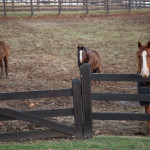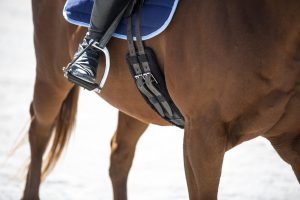 Every horse is an individual and will react to things, events, and situations in different ways. Our responsibility as riders and horse owners, and one of the biggest challenges I run into as a trainer is adjusting my approach, technique, and expectations to work with each individual horse.
Every horse is an individual and will react to things, events, and situations in different ways. Our responsibility as riders and horse owners, and one of the biggest challenges I run into as a trainer is adjusting my approach, technique, and expectations to work with each individual horse.
Horses can have complex personalities that create their emotions, responses to events or objects, and their learning style and capabilities. Discussing how equine personalities are created opens the nature vs. nurture debate that is just as easily applied to our own personalities and emotional lives. Breed and genetics certainly have a big role in determining who our horses are and how they behave. This is so true that even the old horseman’s adage about examining swirls now has some scientific backing. (See this post: What’s in a Swirl?)
However, experiences also play a huge role in shaping how our horses react in different situations or to different training questions – and I am not referring only to a bad experience with the horse trailer that creates a difficult loader – experiences can have an even deeper effect on our horses. For example, a once curious and outgoing horse can begin to display signs of a condition called “learned helplessness” if rough training methods are used that teach the horse that nothing he does will release the pressure or get rid of the pain being afflicted on him. Likewise, horses that are trained through punishments tend to act more withdrawn, unlikely to offer new behaviors during training and much slower to learn because they are afraid to do anything different in the fear it may bring more punishment.
On the contrast, when training is done correctly and fairly, the horse can learn to “search” for the right answer to training questions. Horses can “learn to learn” meaning that the more new things they are taught the faster they pick up on the next new thing in training.
Even the way we manage our horses can have a huge effect on their behavior, their responses in training, and what we view as their personality. For example, a horse who is kept in the stall, or isolated from other horses for an extended period of time is more likely to show signs of excess energy or frustration. In fact, a recent documentary film I watched on wild horses stated that our domesticated horses exhibit 20x more aggressive behaviors than their wild cousins. (Epona TV)
We could go on and on about different experiences that make out horses who they are, however, it is without question that different horses can react in very different ways to the same training exercise or technique.
This is why I believe that as riders, we need to have a “toolbag” of training techniques, so that we have a variety of strategies to use when things don’t go as planned. I feel that it is very important for us not to get caught in too rigid of a pattern or way of doing things. A good example of this is a horse that I am working with now who is challenging me in many ways. Promise is a 5 year old TB mare – she has 11 starts on the track and was given to me last winter after developing the habit of bucking off her previous owner. I have used a lot more positive reinforcement and food in her training than any of the other horses I am working with at the moment. Promise has so many negative associations with everything, especially related to riding, and the food is helping “counter – condition” those associations, or in plain terms just change her emotions around riding, clippers, and everything else that upsets her.
I believe that an openness to try new things and sometimes just go with your gut is very important when working with our horses. I love this quote from Carolyn Resnick: “What makes all good horse trainers able to be so successful with horses that are difficult? It’s because we are comfortable with not knowing what we are doing.”
So the next time your horse doesn’t respond as expected, or is difficult in any way, think about everything that could be affecting how his brain operates and why he is responding that way, plus remember that quote from Carolyn, and be grateful for challenges and the learning opportunities that the difficult horses present. Also, keep growing your training tool bag and don’t be afraid of new ways of doing things!
See you in the comments,
Callie
Sources:
http://epona.tv/real-ethology-with-lucy-rees
http://www.animalsandsociety.org/assets/library/
http://www.equineresearch.org/support-files/hanggi-thinkinghorse.pdf














9 Responses
Great article! I love that quote. Makes you step back and ponder your interactions with other humans as well. It is amazing how much horses can teach us about ourselves!
Love this quote from Carolyn Resnick too!
My Hucul mare is different than the horses I knew before. She grew up semi-wild in the zoo, was first trained at the age of 8 years, she is more likely to fight than to flight . She is very confident and does not like to be bossed around. If you can motivate her she goes through everything with you, if not she goes head through the wall. You often have to take a step back and think “why is she reacting this way?” – I can tell you: she was always right and I was wrong. But no matter what I did wrong yesterday, the next day she takes me back the way I am…
It is amazing how forgiving our horses are and how many mistakes they put up with from us!
Great article. Thank you. Our relation to horses should be determined by admiration of theire beauty,
of love and respect of these wonderful flight animals. Our approach to them and our training endea-
vours must never be by punishement ( especially not when we are frustrated or angry ), but only
disregard of unwanted behaviour and reward of understanding and learning of our wishes and helps. Of course we must know as exactly as possible what we want to teach the horse and to what
purpose. We want to promote and encourage the natural gifts and qualities of the horse in order to
get an easily rideable and supple horse which is content to carry us around and to share with us its
amazing power, speed and also its friendly and goodnatured character.
Well said, Michael!
Hi Callie,
Thanks for this great post! The horse that I ride was traumatized when she was being broken in, and now whenever you tie her up, she rears and pulls back until she gets away. Do you think that I could use food or something to help her with this? What would be the best way to help get her past this? Thanks!
Hi Lydia – try using a lunge line or long lead rope and looping it around the fence or post. Just one loop and then you hold the end of it. This way when she pulls back she won’t get away and break anything and the pressure won’t be released because you are holding the other end of the rope keeping it tight. As soon as she stops backing up and moves forward even slightly the pressure will give. It isn’t a quick fix but I have found that this works very well to teach horses that pull back that they can’t get away from the pressure or being tied – the release only comes when they move forward again. Plus it is much safer for the horse then tying them somewhere “hard and fast.”
Hi! One tool that I absolutely love that would also be useful for this type of problem is the Tie-blocker ring. There are also clips that hold the end of the lead rope that allow that “give” which keeps the horse from feeling trapped.
Hi Nancy, Thanks for the suggestion – I have never used a tie-blocker ring but it sounds interesting!